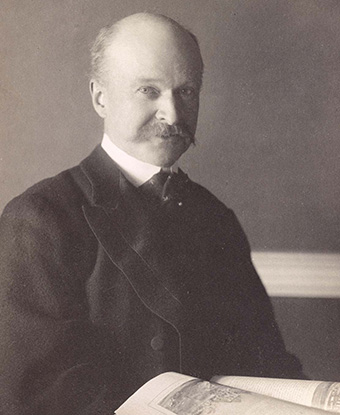Last updated: June 27, 2023
Person
Charles Follen McKim

Library of Congress Photo
Charles Follen McKim is one of the most celebrated American architects of the late nineteenth century. Along with William Rutherford Mead and Stanford White, he provided the architectural expertise as a member of the partnership McKim, Mead & White.
McKim was born in Chester County, Pennsylvania to Presbyterian minister and abolitionist James Miller McKim (1810-1874) and Sarah Speakman McKim. After attending Harvard University, McKim studied architecture at the École des Beaux-Arts (“School of Fine Arts”) in Paris from 1867-1870. Upon his return to America, he was employed as a draftsman in the office of Gambrill and Richardson in New York City and fell under the influence of his mentor, architect Henry Hobson Richardson (1838-1886), while the latter was completing Trinity Church in Boston.
In 1879, McKim formed his own firm in partnership with William Rutherford Mead (1846-1928) and Stanford White (1853-1906) and together established the most successful and influential architectural practice of its time. In the early years of their practice, the firm specialized in the design of informal summer homes for the wealthy, clustered in the areas of Long Island, the New Jersey shore, and Newport, Rhode Island.
In later years, McKim became a major proponent of classical architecture in the tradition of the Italian Renaissance. Among the celebrated examples of this era (sometimes referred to as the American Renaissance), are the Boston Public Library (1887), the Columbia University library (1893), the University Club (1899), the Morgan Library (1899), and Pennsylvania Station (1904-1910; demolished). Many of their residential projects for the American millionaires during this time are also based on classical concepts.
With Daniel Burnham (1846-1912) and Richard Morris Hunt (1827-1895), McKim oversaw the building program of the World’s Columbian Exposition at Chicago in 1893. The impact would establish a neo-classical revival and have a profound effect on architecture across America for decades to follow.
McKim suffered from depression as early as 1878. His personal life was plagued with a series unpleasant and tragic circumstances. McKim first married Annie Bigelow in 1874. Four years later, she divorced him, alleging “unnatural acts” according to biographer Mosette Broderick who surmises this might have been an allusion to homosexuality. Annie obtained sole custody of their daughter and changed the girl’s last name. McKim did not see his daughter again for nearly two decades. McKim later married Julia Amory Appleton in 1885. Julia, and McKim’s child with her, died a year and a half later. But some measure of happiness came in 1899 when he was reunited with his daughter, and he received two important commissions—the monumental Pennsylvania Station (completed in 1910), and an architectural gem, the Morgan Library (completed in 1906).
McKim was a perfectionist, painstakingly committed to classical precedents. His buildings are distinct from the more exuberant examples by his partner Stanford White. McKim’s buildings are marked by dignity and sobriety, committed to the purest forms of classicism. He was a highly persuasive personality, and knew what was aesthetically correct. McKim never argued with his clients, but often got his way through polite persistence.
McKim suffered a breakdown in 1908 and died the next year at age 62.
McKim was a member of the Congressional commission for the improvement of the Washington park system, the New York Art Commission, the Accademia di San Luca, the American Academy in Rome, and the Architectural League. He became a National Academician in 1907.
McKim received numerous awards during his lifetime, including the Medaille d'Or at the 1900 Paris Exposition and a gold medal from Edward VII of the United Kingdom (for his work on the restoration of the White House). He received honorary doctorates from the University of Pennsylvania and Columbia University, an honorary degrees of A.M. from Harvard, and from Bowdoin. He was elected a Fellow of the American Institute of Architects in 1877 (and served as its president), and posthumously received the American Institute of Architects Gold Medal in 1909.
